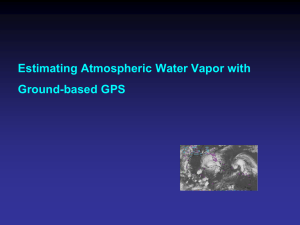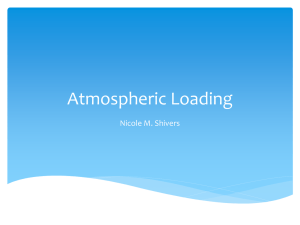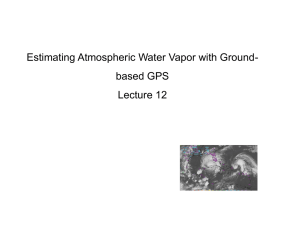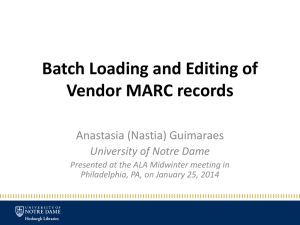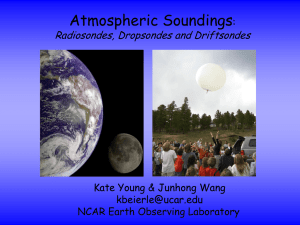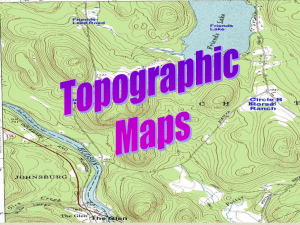Extraction of atmospheric parameters
advertisement
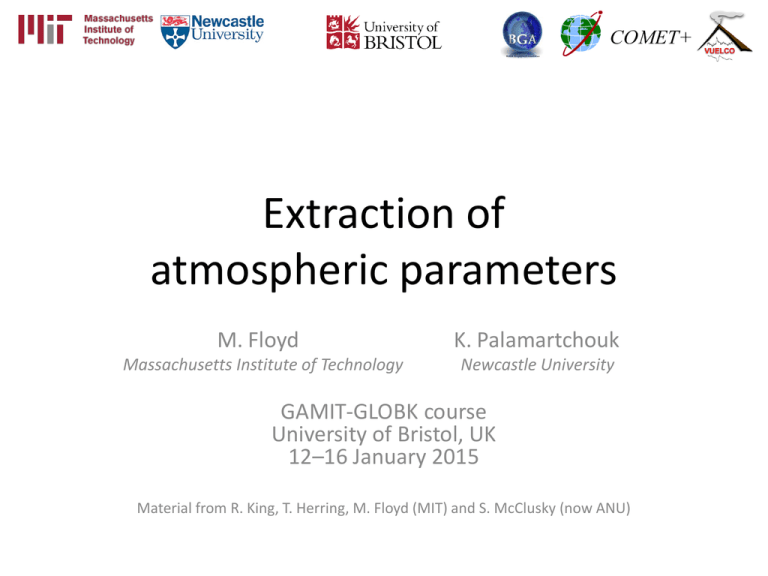
Extraction of atmospheric parameters M. Floyd K. Palamartchouk Massachusetts Institute of Technology Newcastle University GAMIT-GLOBK course University of Bristol, UK 12–16 January 2015 Material from R. King, T. Herring, M. Floyd (MIT) and S. McClusky (now ANU) Severe meteorological conditions • Other factors to consider: – Rapid change in atmospheric pressure affects (dry) hydrostatic delay (mostly function of pressure and temperature) • Low pressure reduces ZHD, possibly making site appear higher (consider position constraint) • BUT, also reduces atmospheric loading, which physically raises site position (~ 0.5 mm/hPa) • BUT, additional loading due to raised sea-level (“inverted barometer”) physically lowers site position proportionally near coasts – Heavy rainfall creates short-term, unmodelled surface loading – Storm surge creates short-term, unmodelled ocean loading • Additional loading physically lowers site position • How to deconvolve competing physical and apparent effects? GPS for surface hydrology • Possible to use direct surface multipath signal to infer local vegetation growth and decay, soil moisture and snow depth. • http://xenon.colorado.edu/portal/ Challenges and Opportunities in GPS Vertical Measurements • “One-sided” geometry increases vertical uncertainties relative to horizontal and makes the vertical more sensitive to session length • For geophysical measurements the atmospheric delay and signal scattering are unwanted sources of noise • For meteorological applications, the atmospheric delay due to water vapor is an important signal; the hydrostatic delay and signal scattering are sources of noise • Loading of the crust by the oceans, atmosphere, and water can be either signal or noise • Local hydrological uplift or subsidence can be either signal or noise • Changes in instrumentation are to be avoided Time series for continuous station in (dry) eastern Oregon Vertical wrms 5.5 mm, higher than the best stations. Systematics may be atmospheric or hydrological loading, Local hydrolology, or Instrumental effects Effect of the Neutral Atmosphere on GPS Measurements Slant delay = (Zenith Hydrostatic Delay) * (“Dry” Mapping Function) + (Zenith Wet Delay) * (Wet Mapping Function) • To recover the water vapor (ZWD) for meteorological studies, you must have a very accurate measure of the hydrostatic delay (ZHD) from a barometer at the site. • For height studies, a less accurate model for the ZHD is acceptable, but still important because the wet and dry mapping functions are different (see next slides) • The mapping functions used can also be important for low elevation angles • For both a priori ZHD and mapping functions, you have a choice in GAMIT of using values computed at 6-hr intervals from numerical weather models (VMF1 grids) or an analytical fit to 20-years of VMF1 values, GPT and GMF (defaults) Percent difference (red) between hydrostatic and wet mapping functions for a high latitude (dav1) and mid-latitude site (nlib). Blue shows percentage of observations at each elevation angle. From Tregoning and Herring [2006]. Antenna Phase Patterns Modeling Antenna Phase-center Variations (PCVs) • Ground antennas – Relative calibrations by comparison with a ‘standard’ antenna (NGS, used by the IGS prior to November 2006) – Absolute calibrations with mechanical arm (GEO++) or anechoic chamber – May depend on elevation angle only or elevation and azimuth – Current models are radome-dependent – Errors for some antennas can be several cm in height estimates • Satellite antennas (absolute) – Estimated from global observations (T U Munich) – Differences with evolution of SV constellation mimic scale change Recommendation for GAMIT: Use latest IGS absolute ANTEX file (absolute) with AZ/EL for ground antennas and ELEV (nadir angle) for SV antennas (MIT file augmented with NGS values for antennas missing from IGS) Left: Phase residuals versus elevation for Westford pillar, without (top) and with (bottom) microwave absorber. Right: Change in height estimate as a function of minimum elevation angle of observations; solid line is with the unmodified pillar, dashed with microwave absorber added. [From Elosequi et al.,1995] Effect of error in a priori ZHD Difference between: a) Surface pressure derived from “standard” sea level pressure and the mean surface pressure derived from the GPT model b) Station heights using the two sources of a priori pressure c) Relation between a priori pressure differences and height differences. Elevationdependent weighting was used in the GPS analysis with a minimum elevation angle of 7° Short-period Variations in Surface Pressure not Modeled by GPT Differences in GPS estimates of ZTD at Algonquin, Ny Alessund, Wettzell and Westford computed using static or observed surface pressure to derive the a priori. Height differences will be about twice as large. (Elevationdependent weighting used). Example of GPS water vapor time series GOES IR satellite image of central US on left with location of GPS station shown as red star. Time series of temperature, dew point, wind speed, and accumulated rain shown in top right. GPS PW is shown in bottom right. Increase in PW of more than 20mm due to convective system shown in satellite image. Annual Component of Vertical Loading Atmosphere (purple) 2-5 mm Snow/water (blue) 2-10 mm Nontidal ocean (red) 2-3 mm From Dong et al. J. Geophys. Res., 107, 2075, 2002 Atmospheric pressure loading near equator Vertical (a) and north (b) displacements from pressure loading at a site in South Africa. Bottom is power spectrum. Dominant signal is annual. From Petrov and Boy (2004) Atmospheric pressure loading at mid-latitudes Vertical (a) and north (b) displacements from pressure loading at a site in Germany. Bottom is power spectrum. Dominant signal is shortperiod.
